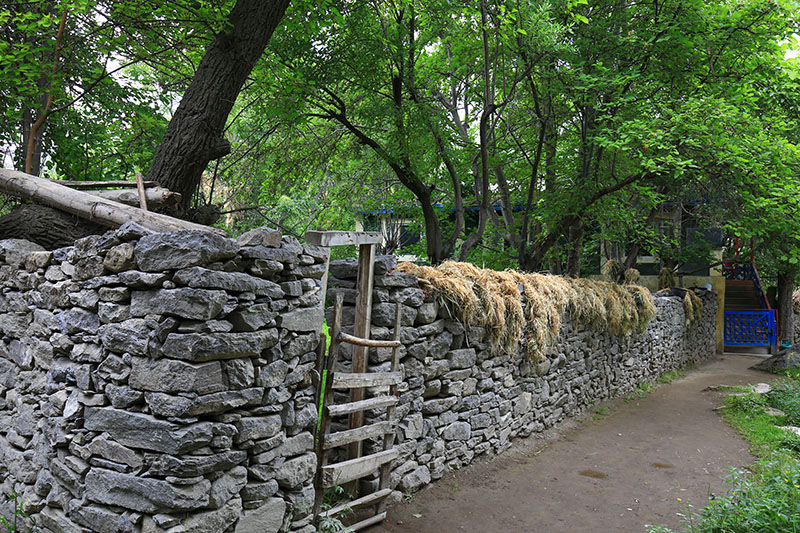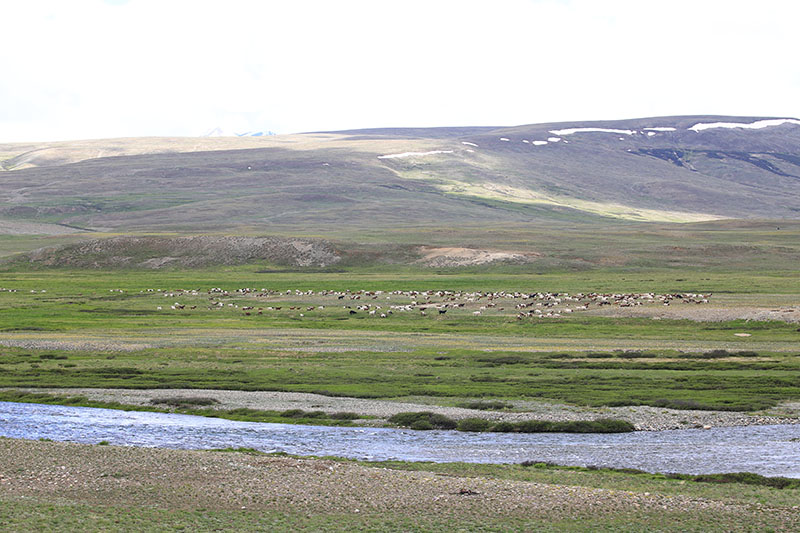In July 2016, Wanderlust-1 took us travelling through Kaghan to Gilgit and up the Karakoram Highway to Hunza. We made it as far as the Khunjerab border and, in fact, as a special privilege we were even taken across the line to the Chinese custom and immigration office. Special it indeed was because Khunjerab had become like any international border crossing in Asia: strict.
Things had changed since my last visit in 2010. Until then visitors from both the Chinese and Pakistani sides were free to wander around this or that side of the border. I had likened it to most borders in Europe and wrote at that time that this was like international borders in the world should be. After that things went south pretty fast and in 2016, we found a mean looking Chinese guards with even meaner looking assault rifles held at the ready.
After the trip, short videos of the proceedings went up on the Annemarie-Schimmel-Haus website. Much to the surprise of all of us, word reached us this year that the restaurants where we dined in Hunza and the people we spoke to on video had become great hits with visitors.
The year 2017 was a dud so far as the wanderlust series was concerned. André, our director for the series, was busy elsewhere. This year, 2018, preparations began early. And so it was that we got away from Lahore on 26 July. From experience we knew that getting into Naran in the evening would be impossible because of the horrendous traffic jams the once pristine and uncrowded hill resort now suffers during the tourist season. We therefore planned to stop a few kilometres short for the overnight halt.
Parhena Cottages, about eight kilometres downstream of Naran were a pleasant stopover. The management was good enough to serve us breakfast an hour before the usual opening time. And we escaped through Naran before the sole street became clogged with disorderly traffic.
27 June. The halt at Babusar Pass seems to be mandatory now. As everyone loitered about I got talking to a honey-seller. I told him the Naran apiaries fed their bees sugar syrup so that they could have a load of honey in as short a time as possible. He lifted a comb to show me that real honey did not fall in drops but made a continuous narrow streak. I told him that was because of the cold temperature and the man left me in a hurry.
Word for all visitors to Kaghan and other mountain valleys where locals flaunt ‘real’ honey: the honey is real all right because it is processed by bees. But the bees do not fly from flower to flower collecting nectar. Instead, they have pans of thick sugar syrup to feed on and process. Hence the honey has no flavour, bouquet or consistency and is rich with sugar crystals. Sacks of sugar can be seen in the tents of the bee-keepers with large plastic drums to prepare the sugar syrup which is served to the bees in pans kept out of sight of nosy visitors.
The Indus Gorge was already a furnace when we hit it midmorning. But the nightmare awaited us after the turn off for Skardu. In mid-2018, there is no blacktop road. There is only a very bumpy unpaved track. Astak with the new PTDC motel was made in about two or a little more hours. We paused at the old teashop and dosshouse for a cuppa.
A little further on we came to halted traffic. After waiting for about half an hour one of us walked up to see the cause of the hold up. A lorry with a broken rear axle stood in the middle of the track listing to the left. Once again I marvelled how these things always happen at the exact bottleneck where both sides have either a house or an electricity pole so that no other traffic can squeeze past.
Some military engineers who are trying to build the road came up looking very officious. But that was all. One of them told all drivers to tuck their vehicles as close as the ditch on the left side so that the ‘loader’ could pass through to move the broken down vehicle. Only the poor thing had a very bad sense of estimation of the loader’s width. Either that or he expected it to fly above the traffic.
The broken down lorry remained where it was but after waiting about two hours our driver suddenly seemed to become possessed. Nosing out of his position in the line, he sped right up to the lorry and after much forward and back managed to squeeze his minibus through the space without so much as a scratch to the bodywork. The episode reminded me of travel on this road back in the 1980s when such holdups were routine. And so we rolled into the Skardu PTDC motel at a little after midnight.
28 July. Drove back 35 kilometres to Kachura. Was surprised to see a blacktop road of good condition leading up where twenty-eight years ago we had ridden a jeep. Parking at the bridge over the stream, our team trailed off in the direction of the Upper Kachura Lake. All those years ago we had walked up through fruit trees and blocks of agriculture; now it was all built up. Two little girls in school uniforms sat in the veranda of an under construction house eating. They invited all passersby to their meal. A little later they caught up with me and plied me with the usual why and from where routine.
And elderly man greeted me and I told him I had returned after twenty-eight years to find Upper Kachura completely changed. ‘In twenty-eight years the world changes. Why, the way we are going, if you return in two or three years even this little village will not be recognisable!’ He was surprised when I told him that though I had returned to Skardu several times in this period, I had never ventured here.
‘Does that mean you did not like our Kachura when you first came?’ he chuckled.
We walked together a bit and he told me of the schools that had come up in recent years. He said my memory of there being absolutely no houses was a bit faulty. There were a few, and those scattered about. He agreed, however, that it was in no way the way it is now and that this was a largely uninhabited area.
One by one our group straggled to the lake shore. But we had to work our way through several restaurants to get there. There were now paddle and motor boats on the lake with scores of tourists. Punjabi boys were yelling at each other at the tops of their lungs. Why do they do that?
The shore around the east and north side is completely built up with red roofs, lakeside patios and smoky kitchens. Only the rocky west is still free of buildings. But I suppose that too will change in time.
There was little trash to be seen, however. Given the large number of tourists, this was surprising. Especially if one knew how the once-pristine Lake Saif ul Muluk has been completely trashed. Imran said he had earlier seen trash trucks in the area.
Done with the filming, we walked up to One Season Restaurant where executive chef M. Sadiq gave us a treat to remember: trout fried with a thin batter. It could hardly have come any better. A native of Kachura, Sadiq works at Monal Restaurant in Lahore and every year takes three months off during peak tourist season to return home. Here he turns his magic on for tourists who would like something more than the chicken handi and karahi. I silently resolved to check him out in the Lahore restaurant later in the year.
Finished at Kachura we drove straight to Khaplu. Thankfully, the road is good! And the old suspension Humayun Bridge over the Indus is now a relic perhaps preserved for those interested in seeing how things once were. Right next to it is a steel and concrete span with two-way track. This new bridge became operational in 2016.
Khaplu was rainy and in the dark we lost our way to Yabgo Khar, the old royal residence, now a star Serena Hotel. After much going up and around in the dark, we finally made it. In 2005, I was part of a team of writers brought here by Aga Khan Cultural Services Pakistan to see how the nearly ruinous palace was being restored. Some sterling work has been done to turn it into what it is now.
29 June. In the small museum inside the hotel, I found some old letters from mid-July 1914. One was signed by a Lieutenant Slingsby of whom I had never heard. His letter says that he surveyed the Saltoro Glacier area. The other, signed one day after Slingsby’s, was by Tom Longstaff. Both letters profusely praised Abdul Karim Wazir who made arrangements for their travel in the area. It is clear that Wazir sahib was a right royal terror in the land whom none dared defy. His administrative skills too were exemplary.
Now, Longstaff was a surveyor on the Survey of India who is accredited with some pioneering work in this part of Baltistan (besides other areas). Among other work, he mapped what is marked as Ganse La on the U-502 series map of this area. Longstaff thus became the first outsider to trek over this glaciated pass.
Actually Gangche in Balti, this pass connects Khaplu in the Shyok River valley with the Indus Gorge near Parkuta (now Mehdiabad). At about 4100 metres, this is a great trekker’s route. But being unfrequented, few Pakistani trekkers know of it. It is therefore largely unspoilt.
After filming around town we drove back to Skardu through a thin drizzle.
 30 June. We began by recording in the mountaineering museum in the lawns of PTDC motel. This is a gift from Italian mountaineers to mark the fiftieth anniversary of the maiden climb of K-2 in 1953. It’s a compact place with a wonderful collection of maps and images going back to the early years of the 20th century.
30 June. We began by recording in the mountaineering museum in the lawns of PTDC motel. This is a gift from Italian mountaineers to mark the fiftieth anniversary of the maiden climb of K-2 in 1953. It’s a compact place with a wonderful collection of maps and images going back to the early years of the 20th century.
From the motel we drove out a short ways through the bazaar to a graveyard where our transport was parked and we walked up to Kharfocho, the little fort sitting snugly on a ledge of the towering hill. We had heard the fort was now under army control and because soldiers go paranoid when they see a professional camera, Zia did not take the video equipment. There was no one there save a wasted old blighter with a serious deficit of teeth and an unnatural and fawning admiration of the army. Thankfully, the fort has not gone to seed any more than it was in 1990.
Our next leg on Wanderlust 2 was Shigar. Yusuf Hussainabadi was not available to show us his museum in Hussainabad just outside Skardu as we had planned to do on the way out. We made arrangements to meet him the following day and drove to Fongkhar in Shigar. Once again AKCSP worked a miracle on a historical building that was virtually a heap of rubble in 1990.
Fong Khar signifies Rock Fort and the reason for this name is a large lump of rock that is part of the architecture. It seems that when they were building this castle, they had no means to dismantle the hard lump of granite and raised the walls around it. Hence the title.
Serena Fongkhar is daily swamped by a few hundred visitors who just come up from Skardu to look. They pay good money (Rs 200 per head, I think) to shilly around the grounds and the building and even poke their heads into guests’ rooms.
1 July. Hussainabad lies about 20 kilometres east of Skardu and that is where we drove back to meet Yusuf Hussainabadi, professor, author of books and collector. I had met him several years ago, but it was in 2012 when I was stranded in Skardu because of bad weather that I came to know of his museum. Set amid a lovely rambling garden, the museum with over four thousand pieces was then crammed into a small room. Now there was a large hall. But even this was getting crowded as the collection grows and Yusuf plans a larger premises.
We still had to get a feel of Shigar Valley, the way all mountaineers and trekkers head for the great knot of high peaks and the longest glaciers in the world outside the Polar Regions. Lush and with laden apricot trees, Shigar was the place to be in. We drove to the end of the blacktop road and on the way back paused at an under construction house.
The young man helping the labourers was single. He said the family needed the new house because they were growing. I asked if he was planning to wed any time soon. With a twinkle in his eye he said he would when the new house was ready.
It was a lazy afternoon after that. But of course there was the polo match between Shigar 1 and Shigar 2. Watching the players until half time, I felt that this was a somewhat slow speed demonstration compared to the very spirited tussles I have seen in Gilgit and Chitral.
2 July. Despite our best laid plans, we were late in getting away for Deosai. It was not before 11:30 that we got to the Himalayan Wildlife Foundation camp at Bara Pani. It has come a long way from the camp where I stayed several times beginning in 1996. Now they have a semi-permanent hut and a couple of igloos. Also, the restaurant near the bridge on the river is a more elaborate set up of tents and furniture to cater to the increased tourist flow.
It was to take two hours out to the area HWF staff know as Black Hole, the best place for bear watching. That would have meant being benighted on Deosai. Instead, we hiked up the nearest ridge to look into the area towards Shatung where the late Rafiq Rajput and I had in 1997 seen a solitary male. But this time we were not so lucky.
We drove on to the ridge in the south from where we could look into the Kala Pani side before returning to the bridge and the restaurant for tea. It was very disturbing to note that despite the signs warning against littering and the rubbish bins installed by the road, Deosai is littered. All those who visit this pristine national park are rich and educated. Many have travelled abroad, yet they have no qualms tossing out empties of all sorts from their car windows. The most revolting sight was a freshly discarded pamper!
By 6:30 in the evening we were back in Skardu. With plenty of footage to create another great series of short films to draw from Zia, Andre, Razi (our sound man) and the rest of the team were very satisfied. The success of the Wanderlust 1 films has been very encouraging. We hope that this latest work will do for Baltistan what the first did for Hunza.




Leave a Reply